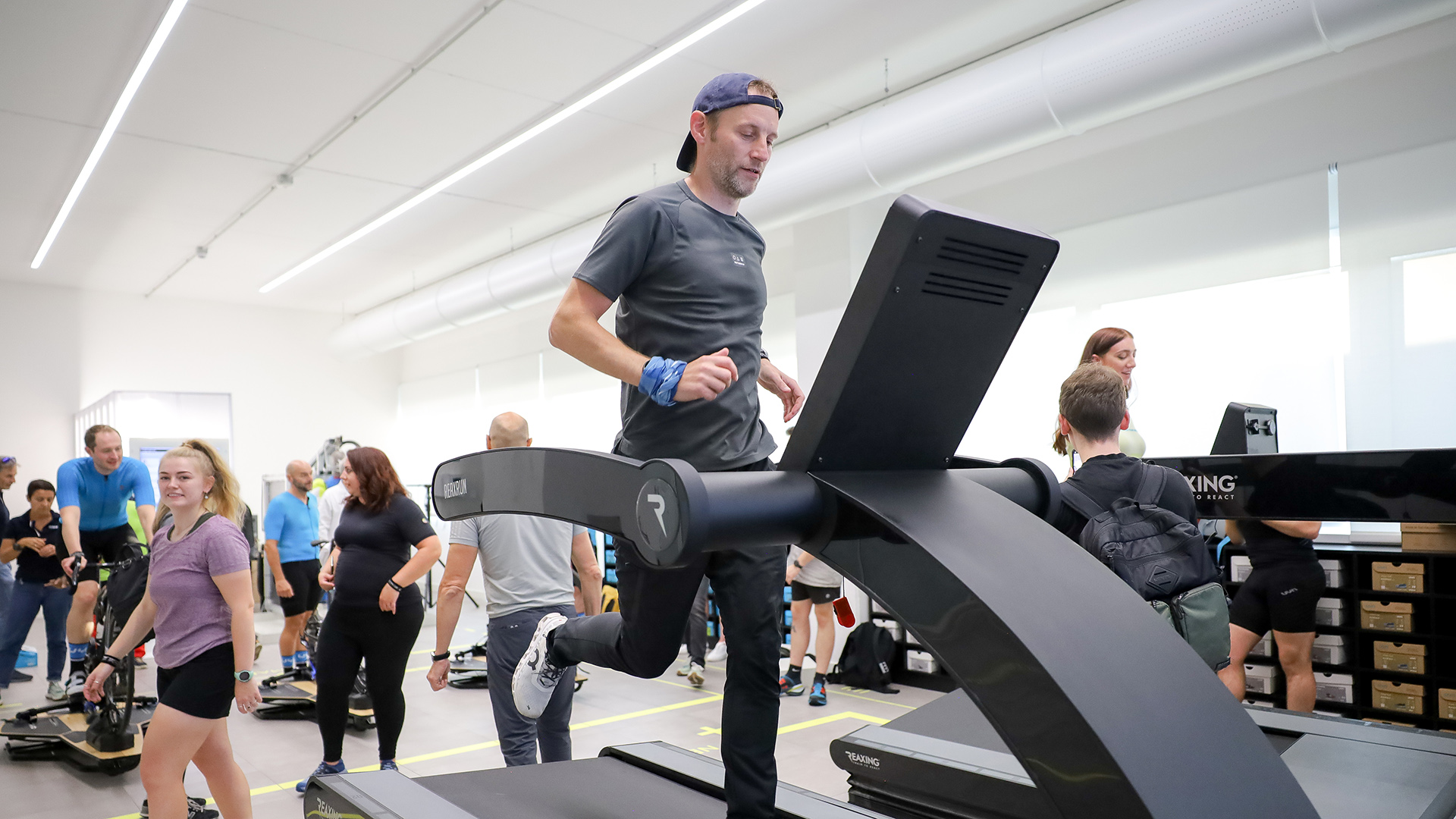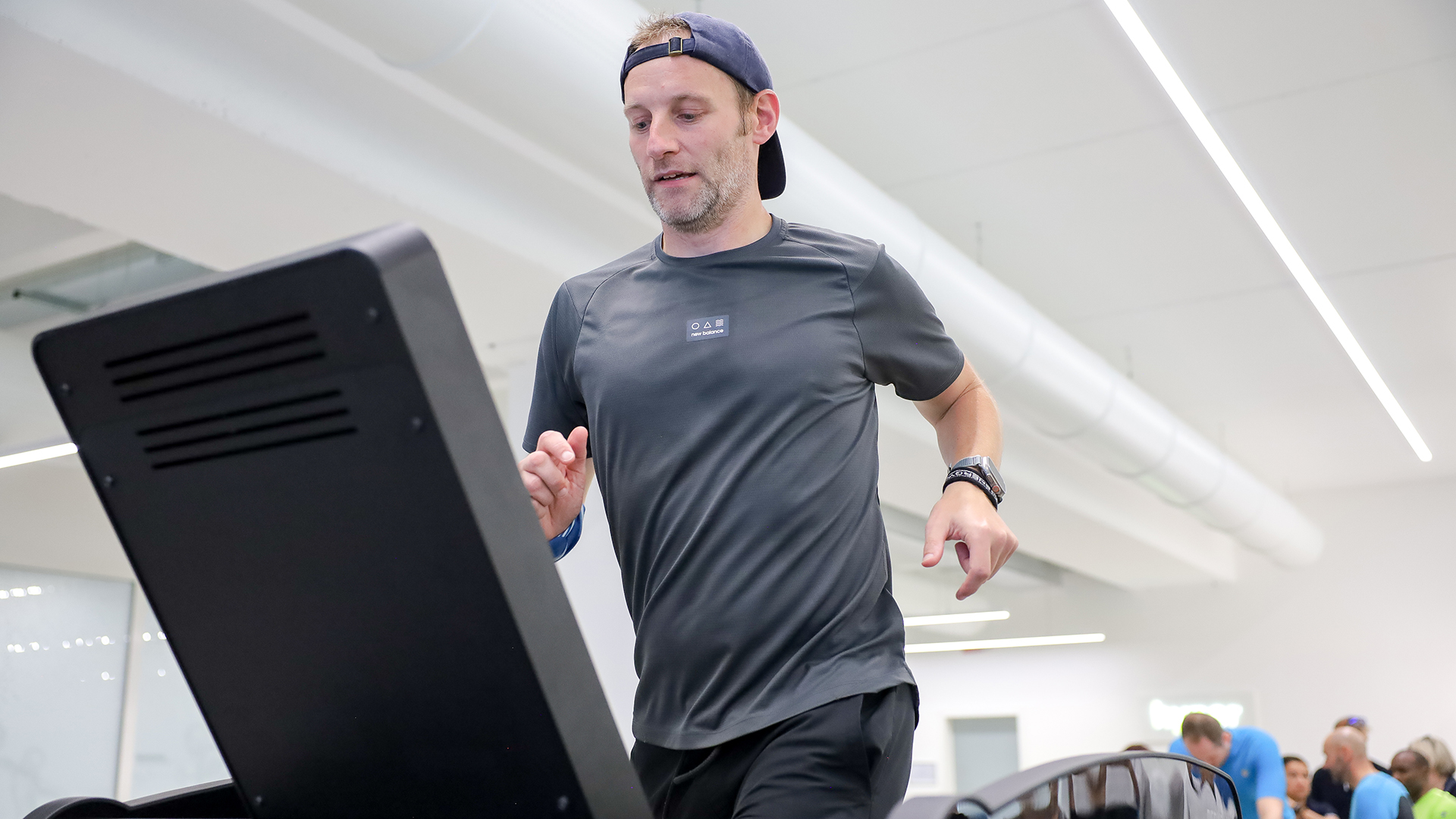I ran on the world’s most advanced treadmill – and it was an experience!
What is it like to run on the world’s first 3D motion treadmill?


There aren’t many runners who find grinding out miles on the treadmill fun. But it is sometimes a necessary evil. When you need to beat the weather and want to run in a controlled environment or at controlled paces, it can be a useful training tool. Now, one company is out to transform the treadmill experience.
Reaxing has created the world’s first and only 3D motion treadmill that tilts, leans and shifts on its axis – at random – to create continuous and unpredictable changes underfoot. But is this new indoor running experience closer to pounding the roads and trails?
I went to the headquarters of performance sports gear experts UYN (external link) to find out. Read my Reaxing Reaxrun hands-on review below to find out what it’s like to run on the world’s most advanced treadmill. It's a lot of fun, especially for those who only tried traditional treadmills before.
Reaxing Reaxrun: How does it work?
The patent pending Reaxing Reaxrun (external link) is the world’s very first 3D motion treadmill. Unlike regular treadmills that can only move up or flat, the Reaxrun belt tilts, leans and shifts on its axis – at random. The result is a treadmill run with the potential for almost unlimited continuous and unpredictable changes in the angle of the belt.
This not only mimics real-world running more closely but it also creates a more challenging run experience that challenges your mind and body more than a regular treadmill by requiring higher proprioceptive activation – that’s essentially your brain and biomechanics working in tandem to respond to the changes underfoot.
This can unlock a range of physiological, metabolic, kinesthetic and neural gains, including higher energy burn, improved balance and a tougher workout for your muscles. Studies show that running on uneven surfaces can increase your energy burn by 5%. It also activates more leg muscles than trotting on smooth terrain.
The Reaxrun comes with 21 different running modes for everything from trail running and fartlek to calorie burn and hiking. These automatically shift the speed and the level of interference (a.k.a. the random changes in the belt position) to help achieve the training goals.
Get all the latest news, reviews, deals and buying guides on gorgeous tech, home and active products from the T3 experts
You can choose between predictable and unpredictable modes, opt for a free run where you control the variables or just use it as a regular treadmill. Another major difference here is that, in addition to doing your regular incline treadmill runs, you can set the belt to run downwards up to -11% decline, without the left and right tilts to recreate downhill running. The maximum side-to-side – or lateral – range of tilt is +/-14%.
The belt has a top speed of 15.5mph. That’s considerably faster than most motorised gym treadmills, which tend to top out at 10-12mph.
There’s also a large, integrated touchscreen where you can see all your mid-run data, as well as an aeroplane-style horizon view that reflects what’s happening with the belt down below. The Reaxrun can also be controlled via partner iOS and Android apps.

Italian performance sports gear creators UYN have even used the Reaxing Reaxrun at their advanced Academy for Research and Engineering in Apparel and Sports (AREAS) to help inform the design of a new line-up of running shoes.
Through tests done on the treadmill, UYN claims it has managed to fine-tune its upcoming running shoes to best align with how our brains tell our bodies to react to changes in terrain.
“Thanks to this new study methodology, we created the first neuro-reactive running shoe using a distinct structure guaranteeing superior stability and optimal movement control, especially in unforeseeable conditions while running outdoors,” says UYN CEO Marco Redini.
There will be three running shoes in UYN’s new line-up, including the Synapsis for road running, the Neuron for trail running, and the 6Sense for cross-trail. They’re due to land at select speciality stores and online starting in spring 2024.
What it's like to run on the Reaxrun 3D motion treadmill
I have to say, I really loved running on the Reaxing Reaxrun treadmill. It was an odd sensation at first that felt really quite unfamiliar. But once you get into the flow, it’s really a lot of fun and a very different kind of challenge.
It’s not like any type of running I’ve ever done before. It’s a much more taxing workout for the brain and the body. But in a good way.
Now, the shorthand here is that the Reaxrun treadmill can replicate outdoor running, even mimic trails. But I’d say that comparison isn’t entirely accurate.
Unlike running on real trails, you’re never quite sure when the down or side tilts are coming so it’s somewhat harder to predict the road ahead. When you’re trail running, your brain records a snapshot of the terrain ahead, slotting what’s coming in the 10 metres in front of you into your subconscious.
But you can’t do that here. So you have to concentrate hard and respond as quickly as you can when the interference kicks in. So it’s not 100% like hitting the trails, but it is much more mentally challenging than your regular treadmill run.
You can also feel the changes in the belt, challenging your leg muscles and feet in a different way. It took me a while to build the confidence to move the interference dial-up beyond 30%. Eventually, I grew confident enough to use the preset trail mode – where the Reaxrun controls the interference and speed automatically.

Ups and downs
During this 2km run, the interference and speed shifted a lot, and sometimes it hit 87%. That was where things got really wild. The sudden inclines definitely challenge your muscles in a more realistic way. Unlike adding an incline on a regular treadmill, where the slowly rises up, this is much more random and sudden.
You don’t have as much time to prepare for the incoming climb. The changes in incline come far quicker, and you find yourself having to dig deeper, and that works the quads more and feels much more like moving over rolling terrain.
The downhills are also really interesting. Trying to control yourself moving downhill on a spinning belt is a very unfamiliar sensation, so they’re quite tricky to manage. Once again, it’s a different skill to master, but boy, do you feel it engaging your quads!
There have been so many occasions where I’ve been training for a mountain ultra in flat London or, recently, the very hilly Comrades Marathon and wished for a way to prepare better for the downhill. And this might well be it.
However, just like bashing out intervals on a regular tread can’t replace real road efforts, the Reaxrun won’t replace running on real trails, but it certainly plugs a gap.
I’d also absolutely rather be running in nature any day, but I still think this is a really interesting technology that takes the treadmill running experience to another level.
It’s a different challenge, it’s a lot more interesting, dynamic and fun. You have to think more, and you’re definitely working your muscles more.
There’s a huge array of 21 preset training programs, including HIIT and Fartlek, calorie burn, distance, heart rate, constant pace or constant speed gaits, and even outdoor run/walk simulations for hiking and trail that offer all kinds of sessions that are far more varied than your regular tread, too.
As ever, if you could somehow connect the experience with stronger hyperreal visuals, it would take it to the next level. But we’re not there yet, and that’s still a huge technological and practical challenge.
Should you try Reaxing?
Unless you’ve got a lot of space and very deep pockets, you won’t be buying this for your house anytime soon. It’s likely to set you back close to €35,000, and it has a much bigger footprint than a regular tread, so it requires a lot of floor space.
However, I don’t think it’ll be too long before you see this in commercial gyms, high-end fitness studios and sports training centres. It’s probably only a matter of time before we see smaller, cheaper versions tailored more for home use. You will always need a slightly larger running platform so you have room to react.
But this is definitely a big step towards making treadmills a much more potent training tool and those sometimes unavoidable indoor runs much less boring.
If you're feeling inspired, check out T3's best folding treadmill guide for more running machines.

Kieran is a freelance writer and editor working in the space where health, fitness, sports and technology collide. He covers everything from virtual reality and smart scales to the latest wearable health trackers. Kieran is also a borderline-obsessed runner and is passionate about using the latest technology to hack his health in search of marginal gains.